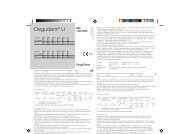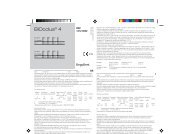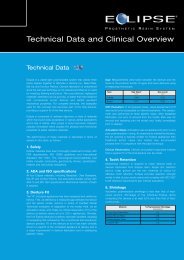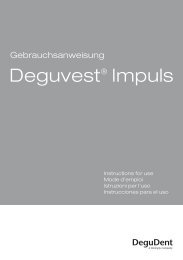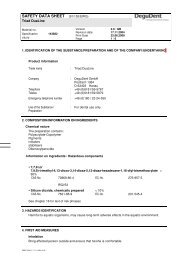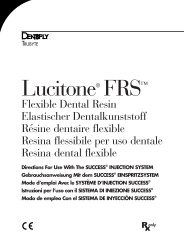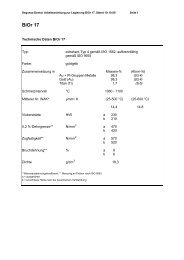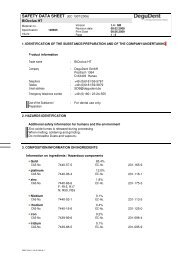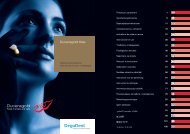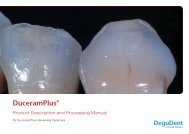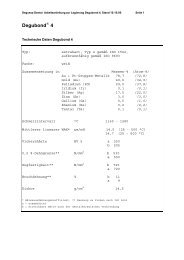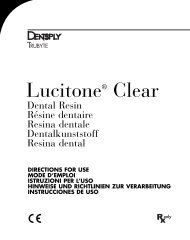Duceram love step-by-step guide GB - DeguDent
Duceram love step-by-step guide GB - DeguDent
Duceram love step-by-step guide GB - DeguDent
Create successful ePaper yourself
Turn your PDF publications into a flip-book with our unique Google optimized e-Paper software.
Step-<strong>by</strong>-<strong>step</strong> <strong>guide</strong> for<br />
veneering non-precious<br />
metal frameworks<br />
DUCERAM LOVE
22196/1101/GVD<br />
Stand/Last revision: 01/2011<br />
Contents<br />
www.<strong>love</strong>-ceramic.com<br />
All laboratory work was executed <strong>by</strong> Bernd van der Heyd, Master Dental Technician, Stübach, Germany.<br />
This description does not replace the regular Instructions for Use.<br />
It is solely intended as a visual <strong>guide</strong> to aid production.<br />
Contents<br />
· Introduction<br />
· Framework design<br />
· Framework preparation<br />
· Applying<br />
NE-Bonder Powder<br />
· Applying<br />
NE-Bonder Paste<br />
· Applying the opaque<br />
· Basic bulid-up<br />
· Firing recommendations<br />
· Material design<br />
<strong>DeguDent</strong> GmbH<br />
Rodenbacher Chaussee 4<br />
63457 Hanau-Wolfgang<br />
Germany<br />
www.degudent.com
Veneering non-precious alloys –<br />
the path to success<br />
The innovative <strong>Duceram</strong> <strong>love</strong> ceramic veneering material can be safely employed on precious and<br />
non-precious alloys alike, for a broad range of indications.<br />
Since non-precious alloys and precious alloys react differently to ceramic firing, ensure that<br />
the following parameters are observed for safe veneering of non-precious alloys with a<br />
CTE 13.8 – 14.9 μm/m · K (25-500 °C):<br />
Conditioning<br />
the framework<br />
Introduction<br />
Applying<br />
NE-Bonder<br />
Applying<br />
the opaque<br />
Dentine and<br />
incisal edge<br />
build-up<br />
Firing sequence<br />
according to firing<br />
recommendations
Framework design<br />
During finishing, the framework must be free of any sharp edges.<br />
Correct<br />
Incorrect<br />
Anterior crowns Molar crowns<br />
Framework<br />
design<br />
Correct<br />
Incorrect<br />
When casting non-precious alloys, it is recommended to use only ceramic<br />
crucibles and to use only new material.
Framework preparation<br />
The frameworks are sandblasted using alumina oxide 250 μm at a pressure of 3–4 bar.<br />
Correct<br />
Incorrect<br />
250 μm / 4 bar 110 μm / 2 bar 250 μm / 4 bar 110 μm / 2 bar<br />
An oxide firing cycle is recommended to check cast non-precious frameworks. Compartis CoCr<br />
frameworks will have been oxidized at the factory, requiring no separate oxide firing. Post-finishing<br />
of Compartis CoCr frameworks requires a new round of sandblasting.<br />
Framework<br />
preparation<br />
Correct<br />
Ceramics<br />
Alloy<br />
Incorrect<br />
Ceramics<br />
Alloy
Applying NE-Bonder Powder<br />
Apply a thin but covering bonder layer of Ducera Liquid B or Ducera Liquid OCL universal.<br />
Oxides will not be able to penetrate the layer.<br />
Wet the surface evenly using<br />
a glass instrument, avoiding<br />
striping.<br />
The thin but covering layer<br />
results in a smooth and even<br />
surface.<br />
Applying<br />
NE-Bonder<br />
Incorrect<br />
Heat the bonder to 980 °C <strong>by</strong> 55 °C/min (best bond through complete vitrification).<br />
If the bonder is not applied<br />
correctly, the framework will<br />
shine through.
Applying NE-Bonder Paste<br />
NE-Bonder Paste must be applied as a fully covering layer. Prior wetting of the framework<br />
with a very thin layer of paste opaque liquid greatly facilitates application of NE-Bonder Paste.<br />
Apply a covering layer of<br />
NE-Bonder Paste with a<br />
paste opaque brush.<br />
If the object is correctly fired,<br />
the bonder will present a<br />
homogeneous semi-matt<br />
surface.<br />
Applying<br />
NE-Bonder<br />
Incorrect<br />
Heat the bonder to 980 °C <strong>by</strong> 55 °C/min (best bond through complete vitrification).<br />
Uneven application may compromise<br />
bond strength. Areas where<br />
wetting was unsuccessful must<br />
be treated and subjected to an<br />
additional paste bonder firing <strong>step</strong>.
Applying the opaque<br />
The framework is prepared <strong>by</strong> applying opaque. The opaque gives the crown its basic<br />
shade and matches the appropriate V-Classic or V-3D shade.<br />
Perform the opaque firing at<br />
910 °C. The surface is homogenous<br />
with an eggshell finish.<br />
The homogenous and voidfree<br />
opaque layer (section)<br />
bonds securely with the<br />
framework.<br />
Applying<br />
the opaque<br />
Incorrect<br />
“Under-firing” of the opaque<br />
will result in voids (porous<br />
regions) that will compromise<br />
bond strength.
Basic build-up<br />
Highly aesthetic restaurations of excellent quality can be created with dentines/incisals<br />
within a minimum of time.<br />
The ceramic powders are mixed with the modelling liquids available<br />
within the <strong>love</strong> system. Ducera Liquid Blend is the new modelling<br />
liquid especially designed for <strong>love</strong> ceramics.<br />
Basic<br />
build-up<br />
Selecting the<br />
modelling liquids<br />
SD Blend Shape<br />
Ducera Liquid Blend combines<br />
the advantages of excellent<br />
modelling properties and longer<br />
working times.
Firing sequence<br />
The firing program was specifically developed for the <strong>DeguDent</strong> range of alloys. Third-party alloys<br />
must be processed according to the manufacturers’ Instructions of Use.<br />
Correct Incorrect<br />
Heating<br />
55°C/min.<br />
Holding<br />
* Non-precious alloys require<br />
6 min of long-term cooling to<br />
relief any stress.<br />
Cooling 55 °C/min. Tempering<br />
*<br />
The highly homogenous<br />
material presents a beautiful<br />
surface lustre.<br />
Maximum stability when veneering<br />
<strong>DeguDent</strong> alloys is obtained<br />
without a tempering phase.<br />
Firing<br />
sequence
General firing recommendations<br />
for non-precious alloys<br />
The <strong>Duceram</strong> <strong>love</strong> firing programs have been explicitly developed for the<br />
<strong>DeguDent</strong> range of alloys.<br />
General<br />
Pre-heating<br />
Drying<br />
Heating Firing<br />
Holding<br />
firing programm<br />
Pre-drying Closing Pre-heating Vacuum No Vacuum<br />
°C<br />
min.<br />
min.<br />
min. °C/min.<br />
°C<br />
min.<br />
min.<br />
NE-Bonder Powder/Paste 575<br />
4/6<br />
2<br />
1<br />
55<br />
980<br />
0<br />
2/3<br />
Opaque<br />
Shoulder 1<br />
Shoulder 2<br />
Dentine 1<br />
Dentine 2<br />
Glaze<br />
FSM / Correction<br />
Stains<br />
550<br />
500<br />
500<br />
500<br />
500<br />
500<br />
450<br />
450<br />
6<br />
1<br />
1<br />
4<br />
4<br />
0<br />
1<br />
1<br />
2<br />
3<br />
3<br />
3<br />
2<br />
2<br />
2<br />
2<br />
1<br />
2<br />
2<br />
2<br />
2<br />
2<br />
2<br />
1<br />
100<br />
100<br />
100<br />
55<br />
55<br />
55<br />
55<br />
55<br />
910<br />
880<br />
860<br />
820<br />
810<br />
800<br />
680<br />
660<br />
2<br />
0,5<br />
0,5<br />
0,5<br />
0,5<br />
–<br />
0,5<br />
0<br />
2<br />
0,5<br />
0,5<br />
0,5<br />
0,5<br />
0,5<br />
0,5<br />
1<br />
Vacuum<br />
hPa<br />
50<br />
50<br />
50<br />
50<br />
50<br />
50<br />
–<br />
50<br />
–<br />
Tempering*<br />
min.<br />
–<br />
–<br />
*3min/850°C<br />
*3min/850°C<br />
The values listed here are intended for orientation only and should be regarded only as <strong>guide</strong>lines. Your firing results may differ. All firing<br />
results depend on the performance of the furnace used, which in turn depends on the brand, model and age of the furnace. Therefore,<br />
the <strong>guide</strong>line values will have to be adapted individually for each firing. We recommend running a test firing cycle to evaluate the performance<br />
of the furnace used. We have compiled and checked all values and other data with great care. However, we cannot under any<br />
circumstances be liable for the individual results.<br />
For the latest firing recommendations for various ceramic firing furnaces please visit www.<strong>love</strong>-ceramic.com<br />
–<br />
–<br />
–<br />
–<br />
–<br />
Cooling*<br />
min.<br />
–<br />
–<br />
6*<br />
6*<br />
6<br />
6<br />
6<br />
–<br />
–<br />
* For alloys with a CTE ≥ 14.6<br />
μm/m · K (25–500°C), shoulder<br />
firing must be extended <strong>by</strong> a<br />
tempering phase (3 min/850°C)<br />
and a cooling phase (6 min).<br />
The firing temperature must be<br />
adjusted to the number of units<br />
fired. Five to ten units require an<br />
increase <strong>by</strong> 5°C to 10°C; more<br />
than ten units require an increase<br />
<strong>by</strong> 10°C to 20°C.<br />
Firing recommendations
<strong>Duceram</strong> <strong>love</strong> – state-of-the-art<br />
innovative material design<br />
With conventional ceramics, the properties of leucite are used to control the coefficient of thermal<br />
expansion. With <strong>Duceram</strong> <strong>love</strong>, the preset coefficient of thermal expansion will not change. The<br />
leucite is restricted to a stabilizing function thanks to the homogeneous distribution of the fine leucite<br />
crystals within the glass phase. The internal tension of the ceramic material will be automatically<br />
adjusted to the appropriate value on strict compliance with the suggested firing program.<br />
Conventional ceramics <strong>Duceram</strong> <strong>love</strong><br />
· Heterogeneous leucite/glass structure with leucite<br />
granules > 50 μm in size<br />
· Component strength 60–70 MPa<br />
· Cooling and tempering required to compensate<br />
for stress peaks<br />
· Delicate structure of leucite crystals with leucite<br />
granules < 5 μm in size for a homogeneous<br />
distribution of tension<br />
· Robust component strength at 100 MPa<br />
· No tempering required<br />
Material<br />
design



